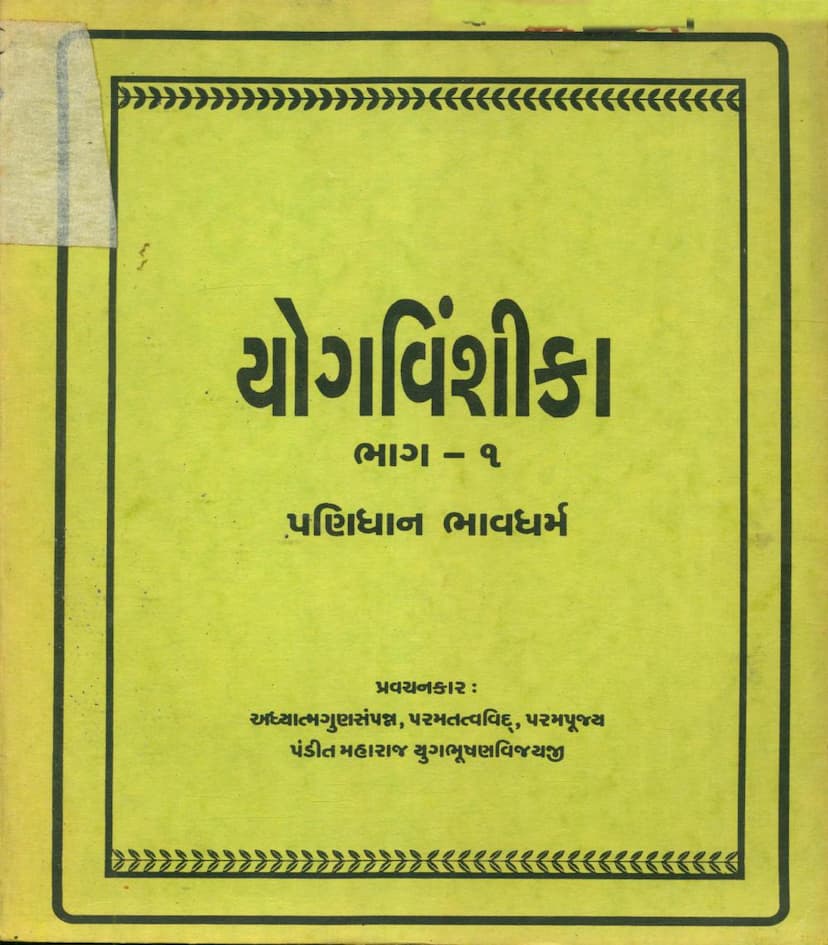Yogvinshika Part 01
Added to library: September 2, 2025

Summary
This is a summary of the Jain text "Yogvinshika Part 01" by Yugbhushanvijayji. The book is a discourse on "Pranidhan Bhavdharma" (Devoted Inner Devotion) and explores various aspects of Jain philosophy, with a particular emphasis on the path to liberation.
Here's a breakdown of the key themes and concepts discussed throughout the provided pages:
1. Introduction to Yogvinshika and the Importance of Dharma:
- The text begins with invocations and acknowledgments, setting a devotional tone.
- It emphasizes the ultimate goal of Jainism: liberation from the cycle of birth and death and attainment of the soul's inherent bliss.
- The teachings are presented as a guide to achieving this, highlighting the importance of "Dharma" (righteousness/duty) as the means.
2. The Nature of True Happiness and the Illusion of Worldly Pleasures:
- A significant portion of the text contrasts worldly pleasures with spiritual happiness (Atmanand).
- Worldly pleasures are consistently described as temporary, fleeting, and ultimately leading to suffering. They are based on sensory experiences, attachment, and desire, which are seen as illusions. Examples are given of how even seemingly enjoyable activities like watching TV or listening to music eventually lead to boredom or dissatisfaction.
- Spiritual happiness (Atmanand) is presented as the true, lasting, and inherent state of the soul. It is described as pure, unadulterated bliss, free from suffering, and attainable through spiritual practices.
- The text critiques the human tendency to chase worldly pleasures, driven by ignorance and attachment, while neglecting the true source of happiness within the soul.
3. The Concept of Yoga and Liberation (Moksha):
- The word "Yoga" is explained in its broader Jain context, not just as physical postures, but as the union of the soul with the divine, the path to liberation.
- Moksha (Liberation) is defined as freedom from all bondage, the soul's release from desires and attachments.
- The text stresses that true happiness and liberation are not attained through external means but through inner purification and self-realization.
4. The Role of Karma and the Cycle of Birth and Death:
- The concept of karma is intertwined with the soul's journey. Actions driven by attachment, desire, and ignorance bind the soul, leading to repeated cycles of birth and death.
- Understanding the bondage of karma is crucial for spiritual progress. The text implicitly suggests that by aligning actions with righteousness and inner devotion, karmic bondage can be weakened and eventually dissolved.
5. The Importance of Righteous Conduct and Inner Transformation:
- The text repeatedly emphasizes the need for inner transformation and righteous conduct ("Samyak") as opposed to mere external rituals.
- "Pranidhan" (Devoted Inner State) and "Bhavdharma" (Inner Devotion) are highlighted as the core elements of true spiritual practice.
- The discourse encourages introspection, self-awareness, and the cultivation of virtues like non-violence, truthfulness, non-possessiveness, and faith.
6. The Journey of the Soul and the Stages of Spiritual Progress:
- The text alludes to the soul's long journey through various life forms and the stages of spiritual development.
- It introduces the concept of "Gun", "Dosh" (qualities and flaws), and the importance of discerning and overcoming flaws while cultivating virtues.
- The journey towards liberation is presented as a progressive path, requiring effort, discipline, and consistent practice.
7. The Concept of "Pradhana" (Importance/Priority):
- A key theme is the importance of identifying what is truly "Pradhana" (essential or of primary importance) in one's life.
- The text argues that in the spiritual path, cultivating inner qualities ("Gun") and overcoming flaws ("Dosh") are of primary importance.
- It distinguishes between superficial actions and the underlying intention and "Pradhana" that drives them.
8. The Role of Understanding and Intention:
- The importance of understanding the true meaning of scriptures and practices is stressed. Mere outward observance without inner understanding is considered insufficient.
- The intention behind actions ("Bhav") is highlighted as crucial for spiritual merit. Actions performed with a pure and devoted intention lead to positive karmic outcomes, while those driven by ego or attachment can be detrimental.
9. The Analogy of the Sheep and the Herd Mentality:
- The text uses the analogy of sheep blindly following a leader to illustrate the danger of blindly adhering to traditions or societal norms without critical thinking and self-reflection.
- It encourages individuals to question, analyze, and understand the true purpose behind their actions and beliefs.
10. The Nature of True Devotion and the Path to Moksha:
- True devotion is not mere outward ritual but an inner transformation characterized by faith, understanding, and consistent practice.
- The ultimate goal is to realize the soul's true nature and achieve liberation from the cycle of rebirth.
11. Distinguishing Between Attachment and Detachment:
- The text differentiates between unhealthy attachment ("Rag") to worldly things and healthy detachment.
- It explains that while attachment to worldly pleasures creates suffering, a healthy detachment from them is necessary for spiritual progress.
12. The Role of Viveka (Discernment) and Self-Reflection:
- The importance of "Viveka" (discernment, wisdom) is repeatedly emphasized. Discernment is key to understanding the difference between the eternal soul and the transient material world.
- Self-reflection is encouraged to analyze one's actions, motives, and progress on the spiritual path.
In essence, "Yogvinshika Part 01" serves as a spiritual guide, urging readers to look beyond worldly illusions, understand the true nature of the soul, cultivate inner virtues, and diligently follow the path of Dharma to achieve ultimate liberation. The teachings are presented in a way that encourages deep thought and introspection.